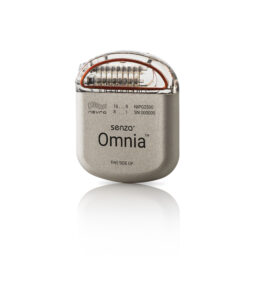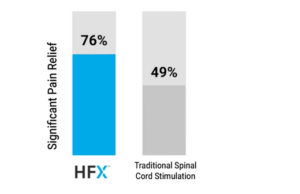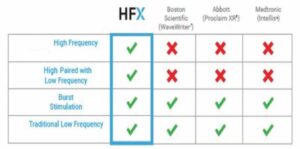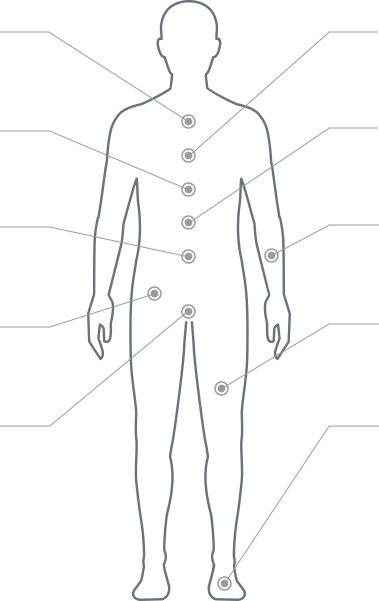What is the Difference Between Traditional Spinal Cord Stimulation and Nevro HFX?

Spinal cord stimulation has been an established chronic pain treatment option for quite some time, but it’s important to know that there isn’t just one type of spinal cord stimulator available.
Just like we’ve seen advancements with cellphone technology, within the last 10 years there have been important advancements in spinal cord stimulation technology and spinal cord stimulator success rates.
As you research and think about the spinal cord stimulator that could be best for you and your pain management goals, it’s important to understand the key differences between traditional spinal cord stimulators and advanced spinal cord stimulators like Nevro HFXTM.
A brief history of traditional spinal cord stimulation
Before jumping right into the difference, it may help to understand a little history of spinal cord stimulation.
Spinal cord stimulation was first developed in the late 1960s1. However, over the next 40 years, traditional spinal cord stimulation saw little improvement in pain relief outcomes.
During those 40 years, about 50% of people with leg pain achieved about 50% pain relief 2-3. Traditional spinal cord stimulation also provided limited pain relief for people experiencing back pain2-3.
Traditional spinal cord stimulators only offer one type of therapy – low frequency. Also, most traditional spinal cord stimulators use paresthesia, often described as a buzzing or tingling sensation designed to mask pain signals, and for some people, this can be an uncomfortable feeling.
Besides limited pain relief and therapy options, traditional spinal cord stimulators have some lifestyle limitations. People who have a traditional spinal cord stimulator typically need to turn their device off when they go to bed and when driving. The ability to get an MRI is also restricted.
These limitations can really impact getting back to everyday life, especially when you’re looking for more freedom and to regain your independence.
How is HFX different from traditional spinal cord stimulation?
HFX is the most advanced spinal cord stimulator available and is different from traditional spinal cord stimulation in several key ways:
Proven to provide more pain relief – spinal cord stimulator success rate
HFX has the highest demonstrated, long-term success rate for chronic back and leg pain relief.
 The largest clinical study ever done for spinal cord stimulation compared the pain relief experienced by people using a traditional spinal cord stimulator and people using HFX.
The largest clinical study ever done for spinal cord stimulation compared the pain relief experienced by people using a traditional spinal cord stimulator and people using HFX.
The study found HFX provided significantly better and longer-lasting pain relief from back and leg pain than other spinal cord stimulators4-5.
76% of people with back pain and 73% of people with leg pain experienced at least 50% pain relief with HFX. Compared to traditional spinal cord stimulation, where only 49% of people with back and leg pain experienced at least 50% pain relief.
The same outcomes for pain relief with HFX were also demonstrated in a real-world study – meaning HFX can provide people with the same pain relief outside of controlled trials in the real world.
More freedom
HFX was created with advancements to provide more freedom and eliminate the limitations people with traditional spinal cord stimulation experienced:
- No more tingling– HFX offers programs that safely reduce your chronic pain without a tingling sensation (paresthesia) – so you just feel relief.
- 24-hour pain relief – HFX offers programs without driving or sleeping restrictions.
- Full-body MRI access* – With HFX, you can safely have a full-body MRI scan so you can receive the care you need.
- 10-year battery life – HFX offers a rechargeable battery designed for a 10-year life6, this means you will undergo fewer surgeries to replace your battery. The non-rechargeable batteries offered with traditional spinal cord stimulators typically have a 2 to 5-year battery life.
The best possible long-term pain relief & success rate for you
Pain is unique and every person experiences pain differently. As spinal cord stimulation technology continues to develop, it’s become more important to consider the mechanism of action used to deliver chronic pain relief.
Mechanism of action may sound complex, but it’s really another way to describe how a device produces the desired effect; in other words, it’s how spinal cord simulation actually works to relieve chronic pain.
When evaluating your spinal cord stimulator options, it’s important to know how each device works. You can see in the chart below, that there are several different programs offered to deliver pain relief:

Traditional spinal cord stimulators can only offer one option – to deliver low-frequency programs. This can limit your pain relief.
HFX is the only spinal cord stimulator that offers both high and low-frequency programs. So, if your pain changes over time, you get the most frequencies and waveforms available for the best possible long-term pain relief with HFX.
See how HFX works here:
See if HFX could be right for you
Pain is complex and can change over time. It’s important to think about choosing a spinal cord stimulator that can provide you with the best possible long-term pain relief.
HFX is the most advanced spinal cord stimulator available – providing people with more pain relief and a better quality of life. Learn more about what to expect with HFX.
If you’d like to see if HFX could be an option to relieve your chronic pain, the first step is to take a short assessment today. At the end, you can request a call from an HFX Coach who will answer any questions you have and help you find an HFX doctor in your area.
Summary
- Understanding the difference between traditional spinal cord stimulation and HFX will help you decide which option is right for you
- There are significant advancements and unique benefits with HFX not offered with traditional spinal cord stimulation
- HFX is the most advanced spinal cord stimulator available: offering both high and low-frequency programs for the best possible long-term pain relief and success rate
Footnotes
*Within conditional parameters. Refer to Senza MRI Guidelines for detailed information on MRI safety and conditions.
Sources
- “History of Neuromodulation.” International Neuromodulation Society, neuromodulation.com/history-of-neuromodulation.
- North R., et al. Spinal cord stimulation versus repeated lumbosacral spine surgery for chronic pain: a randomized, controlled trial. Neurosurgery. 2005; 56(1):98-106
- Kumar K., et al. The effects of spinal cord stimulation in neuropathic pain are sustained: a 24-month follow-up of the prospective randomized controlled multicenter trial of the effectiveness of spinal cord stimulation. Neurosurgery 2008 Oct; 63(4);762-70
- Kapural L., et al. Novel 10-kHz High-frequency Therapy Is Superior to Traditional Low-frequency Spinal Cord Stimulation for the Treatment of Chronic Back and Leg Pain. Anesthesiology, 123(4)
- Kapural L, et al. Comparison of 10-kHz High-Frequency and Traditional Low-Frequency Spinal Cord Stimulation for the Treatment of Chronic Back and Leg Pain: 24-month . Results from a Multicenter, Randomized, Controlled Pivotal Trial. Neurosurgery. Published 09 2016.
- Senza Summary of Safety and Effectiveness Data (SSED). Published May 8, 2015.
- Spectra WaveWriter
- Information for Prescribers Manual. Document 91171759-02. 6. Proclaim Implantable Pulse Generator Clinician’s Manual. 2019-09.
- Medtronic Neuromodulation Clinician Programmer App – Intellis Neurostimulation Systems A710
- Vanta SCS Brochure for Healthcare Professionals – Rev. 0119. 8.
Popular Posts
Take our short assessment to find out if HFX is right for you.
Start NowHFX is covered by all major commercial insurance plans, Medicare, Medicaid, and Tricare.
DOWNLOAD INFORMATION BROCHURERelevant Reads
What to Expect at Your Nevro HFX Consultation
You’ve decided to explore Nevro HFX as a treatment option for your chronic pain. Congratulations! That’s the first step in finding a long-term pain relief solution that doesn’t require drugs or major invasive surgery. A…
How to Choose the Right Pain Management Doctor
If you’ve been living with chronic pain for a long time, you’ve probably tried a wide range of treatment options recommended by your primary care provider. Maybe you’ve tried over-the-counter and prescription medications, physical therapy,…
Why Do I Need a Psychological Evaluation for a Spinal Cord Stimulator?
A spinal cord stimulator is a highly effective treatment option for managing chronic pain. It’s a solution for many people who have tried other ways to manage their pain but haven’t found success with medications,…
How long have you been suffering from pain?
Where is your pain located?
(Select all areas where you experience pain)

On average, rate your pain level over the past 30 days:
No Pain
0 1 2 3 4 5 6 7 8 9 10Worst Pain Imaginable
No Pain
Worst Pain Imaginable
Which treatments have you already tried?
(Select all options you've tried)
What statement describes you best?
Please select your primary type of health insurance:
HFX is covered by all major insurance plans, including Medicare and Tricare.
Commercial insurance is typically offered through your employer or health care exchange. Examples of commercial insurance providers include Blue Cross Blue Shield, Aetna, Cigna, Kaiser, United, and Humana. Close
Thank you for sharing your experience.
At this time, it looks like you might not be an appropriate candidate for HFX. The next best step is to talk with the physician who is treating your pain about your treatment options.
To learn more about who this treatment option is right for, visit our learn center:
Learn MoreOne of the qualifications for HFX is that you need to experience pain for longer than 6 months.
You may not be ready for HFX now, however if your pain lasts longer than 6 months, please come back to see if you qualify.
Learn MoreOne of the qualifications for HFX is that you need to experience moderate to severe pain.
You may not be ready for HFX now, however if your pain severity increases, please come back to see if you qualify.
Learn MoreGood news!
Based on your responses, HFX could be an option for you.
Fill in your information below to get your doctor discussion guide and additional educational information about HFX.
Fill in your information below to connect with your HFX Coach and receive your doctor discussion guide. Your HFX Coach is a real person assigned to you who will answer your questions and help you find an HFX doctor.
Agree to terms
By clicking ‘I agree & submit’, you agree to receive automated SMS texts from Nevro at the mobile number provided and agree to Nevro’s Text Message Terms of Service & Privacy Notice. Message and data rates may apply. Message frequency varies. You can opt-out at any time by texting STOP to 35788. You can also text HELP to 35788 for HELP. You also agree to email and phone communications from Nevro and opportunities to participate in Nevro led research panels and quantitative surveys. You understand that you can choose to participate or decline to participate in any marketing panel. You understand that you can opt-out of further advertising and/or marketing research communications from Nevro by clicking unsubscribe in the email or providing a detailed request to [email protected].
All information will be used in accordance with Nevro’s Privacy Notice.
Looks like you have recently taken the assessment.
Would you like to update your responses?
Your responses are being submitted. Please wait – we’re sending you to a page with more information about HFX.
Please don't click the back button or close your browser. This may take a few seconds.
Your responses have been saved.
Thank you for your time.
Your results and discussion guide will be on their way shortly.
Please find a copy at the email address provided.
Thank you for your time.
We did not update your responses. Your results and discussion guide will be based on your previous responses. Please find a copy at the email address provided.
YOU ARE ABOUT TO EXIT FOR A WEBSITE INTENDED FOR THE RESIDENTS OF ANOTHER COUNTRY OR REGION.
Please be aware that the website you have requested is intended for the residents of a particular country or region, as noted on that site. As a result, the site may contain information on medical devices and other products or uses of those products that are not approved in other countries or regions.
Do you wish to continue?
YOU ARE ABOUT TO ACCESS A WEBSITE INTENDED FOR THE RESIDENTS OF A PARTICULAR COUNTRY OR REGION.
Please be aware that the website you have requested is intended for the residents of a particular country or region, as noted on that site. As a result, the site may contain information on medical devices and other products or uses of those products that are not approved in your country or region.